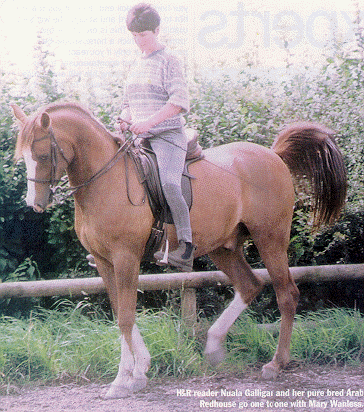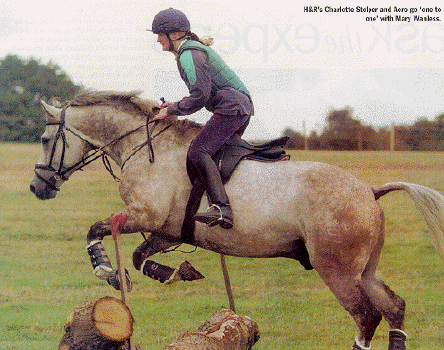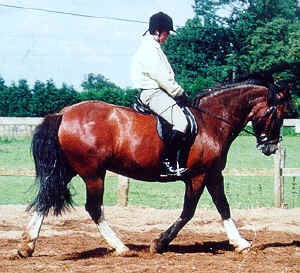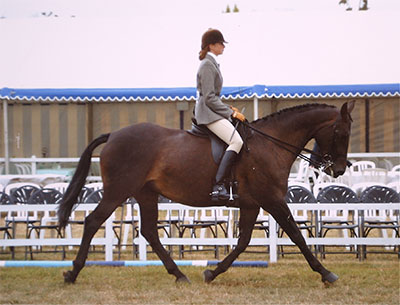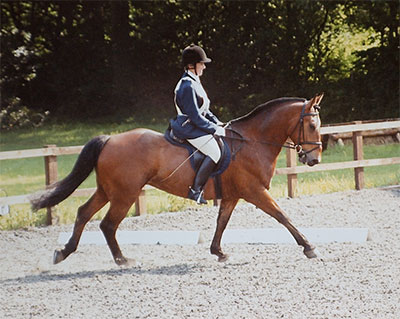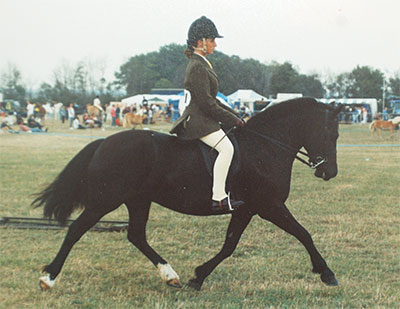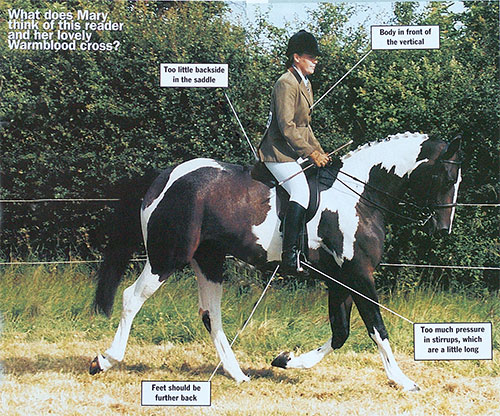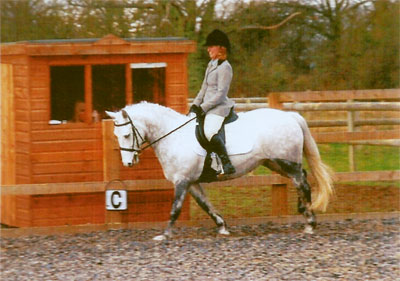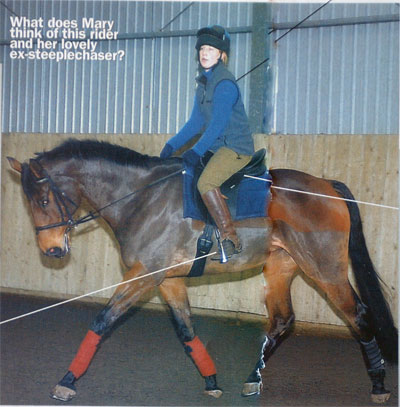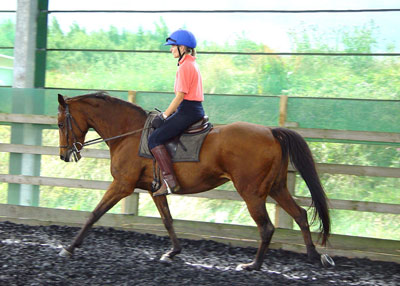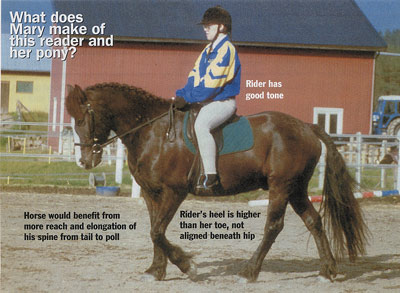RWYM
ARTICLE 6
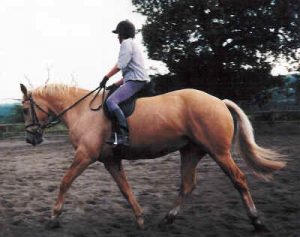 This horse is an Irish Draft x (presumably with thoroughbred). He is a nine-year-old gelding who has been with his present owner for eighteen months. She has competed him in preliminary and novice dressage tests, and has also done some elementaries. She does not tell me whether she has affiliated him, or whether she is only doing unaffiliated competitions. She says that ‘He tends to be lazy, I ride him in spurs and a long whip. He is still often difficult to motivate, although when he is working forward properly he can show good work and paces. My main problem in tests is that even though I get him ‘in front of the leg’ with active paces when working in, as soon as I enter the arena for the test he drops behind my leg and does not show the level of work that he is capable of.’
This horse is an Irish Draft x (presumably with thoroughbred). He is a nine-year-old gelding who has been with his present owner for eighteen months. She has competed him in preliminary and novice dressage tests, and has also done some elementaries. She does not tell me whether she has affiliated him, or whether she is only doing unaffiliated competitions. She says that ‘He tends to be lazy, I ride him in spurs and a long whip. He is still often difficult to motivate, although when he is working forward properly he can show good work and paces. My main problem in tests is that even though I get him ‘in front of the leg’ with active paces when working in, as soon as I enter the arena for the test he drops behind my leg and does not show the level of work that he is capable of.’
Horses are so clever, aren’t they? Despite their innocent little faces they know exactly what our bottom line is, and when we will or will not ‘get after them’. The photograph shows the horse not quite tracking up, but one sees many horses looking far less active, and the overall impression is good. He is reaching nicely into the rein with his nose just in front of vertical. The rider is not pulling back, and hence the horse’s neck is way more ‘unscrunched’ than many. There is a good firmness to her torso – she is bearing down (see last month’s article) and this enables her to give her hand forward. The horse’s tail is nicely carried, giving a good elongation to his whole top-line. One sees this all too rarely, and the rider deserves congratulations for doing this well.
There are some ‘ifs’ about her biomechanics, however, and her head, neck, and shoulders show a lot of tension. Her head is being scrunched down inbetween her shoulders, which are drawn up (the tortoise effect). She is slightly in front of vertical, and needs to bring her shoulders back over her backside. It would help her to think of pulling her shoulder blades down in a ‘V’ shape towards her waistband. The muscles of her backside and thigh have naturally high tone (meaning that their texture is naturally more akin to putty than jelly) and this is a huge help to her. Her thigh, knee, and toe are rotated out, and this has ramifications that we will return to later.
Let’s first take an overview of the issues presented by lazy horses. When a rider appears in front of me on a lazy horse I often tell her that if she is a three-out-of-ten rider, then she can expect to find herself riding a three-out-of-ten horse. When she ups her bottom line to six-out-of-ten, she will suddenly find herself riding a six-out-of-ten horse. Make it eight-out-of-ten, and the horse will find a level of impulsion that she never knew he had! In fact, I used to borrow a very sweet but lazy horse for the students on my courses, and he illustrated this effect to perfection. On two occasions, two of my exasperated assistants said to their pupil, ‘Let me get on this horse and show you how to motivate him!’ As soon as they were each in the saddle he went off like a rocket, and neither of them ever needed to lift the stick!
Nervous riders often go through the motions of trying to get the horse forward whilst also ensuring that they will not ‘rock the boat’ enough to succeed. The rider who does this can kick and squeeze a lot, and appear to put in a lot of effort. Thus she gets ‘Brownie points’ for trying hard, but she never has to deal with the increased energy that – if she were to succeed – might prove rather frightening. She maintains a status quo in which the horse ignores her.
Even if you are not as self-protective as the rider above, it is all too easy to deliver the message, ‘Horse, I don’t really mean it. There are no consequences for ignoring me, and if you don’t go, I shall just keep on kicking…’ Your leg then becomes like the background music in a restaurant or supermarket, which you and your horse so easily cease to hear. He is then ‘dead to the leg’. You yourself may even stop noticing that you are kicking or squeezing much of the time, and if you use your leg on ‘auto-pilot’ what right have you to imagine that your horse should respond to it? Surely you should expect that he too will follow your example, and use ‘auto-pilot’ to tune it out?
Our rider in the photograph may well have fallen into the trap of nudging and squeezing far more than she realises she is doing. Notice how the back of her calf and her spur are against the horse’s side. The question is, ‘Is this a momentary or a permanent state of affairs?’ Even if it is momentary, she has not used her leg in the most effective way. The leg aid needs to be like a slap, that touches the horse’s sides and immediately rebounds. You can slap lightly or with more gusto (the penalty kick), but you do not become more effective by turning the slap into a more prolongued nudge or squeeze. The effort taken to do this reverberates right through your upper body, and you loose the effect of the short sharp shock that is far more motivating to the horse.
I suggest that this rider deliberately rotates her thighs inwards, reaching her hand around the outside and back of her thigh, grabbing the flesh that is against the saddle, and pulling out away from the saddle. This will rotate her knees in towards the saddle, and her heels away from the horse’s sides. She then needs to think of keeping this rotation (which may not be easy) so that she keeps her inside thigh, her knees and the tops of her boots against him all the time. Then, nothing from the knee up must change when she uses her leg from the knee down, and her lower leg in its ‘neutral’ position must remain away from his sides.
If he does not listen when she slaps him with her legs, she must back up that slap either with her stick or with the strategy I suggest below. She might consider taking off her spurs and using them only in competition, so that they give her an ‘edge’. Or she might keep a longer pair for competition. But whatever she does, her must keep the meaning in her leg aids. Her motto must be, if you use it, mean it, and if you don’t mean it, don’t use it.
My best suggestion for dealing with his lazyness in the competition arena is as follows. At home, use your leg lightly, and if he does not immediately respond pick up the loop of your reins cowboy-style, and whack him firmly on both sides of his neck. Be prepared for him to zoom off (after all, he will not know what hit him). Be sure that you remain ‘with him’ and do not topple backwards and/or catch him in the mouth. This is vital, as you do not want to punish him for going; in fact you want to reassure him that you will not be displaced by this extra energy.
Next time he does not respond to your legs, whack him on his neck again, and be sure to ‘go with him’ as he speeds up. You need to be really clever at quickly picking up the loop of the reins, and you want to horse to know that this is the signal that you are about to whack him. He needs to be scared enough to go from that signal, and it must not become as commonplace and ignorable as your leg and stick have become. In a test, you can subtlely pick up the reins and threaten to whack him with them. If you are willing to sacrifice marks in order to revamp his attitude towards competition arenas, you can even whack him on the neck during a test.
This has to class as the most unclassical advice I ever offer anyone, but it is very similar to Monty Robert’s suggestion that the soft ‘whip-whop’ is a better ‘go forward’ cue than a whip. I have used this technique to good effect on horses that are not just lazy, but also ‘backwards’ in their thinking. There have been times when it has changed the attitude of horses that were extremely nappy. These horses might kick out or buck when you use the stick, or might have become immune to beatings. But being hit on the neck with the end of the reins is so unexpected that it shakes them up and changes their ‘mind-set’. Then, once they agree to go, the rider has much more chance to keep her body well organised and doing a good job.
I first realised the power of this during a lesson many years ago with a very classical teacher, who used to torture his students by making us ride an old and lazy Anglo-Arab with no whip and no spurs. Once we had succeeded in making him go forward, there was a chance that he might let us ride one of the nicer horses. But this initiation ceremony was a mighty hurdle to cross.
One day he left the school for a few minutes, and in exasperation I picked up the end of the reins and hit the horse on the neck. He was so shocked that he went off like a rocket, which gave me the chance to organise myself and ride much more effectively. When the horse threatened to become lazy I did the same again. By the time my teacher came back into the school, I only had to begin to pick up the reins and off the horse went. ‘Mary’, said my teacher, in a tone that suggested wide-eyed wondour, ‘I see that you have learned to use your seat!’
I have told this story to many people. (I never admitted my tactic, by the way, and positively basked in the kudos that my trickery earnt for me!) I hope that it helps our rider here, for this looks to be a very nice horse. All she has to do to score extremely well is to keep him sweating more than she does!


